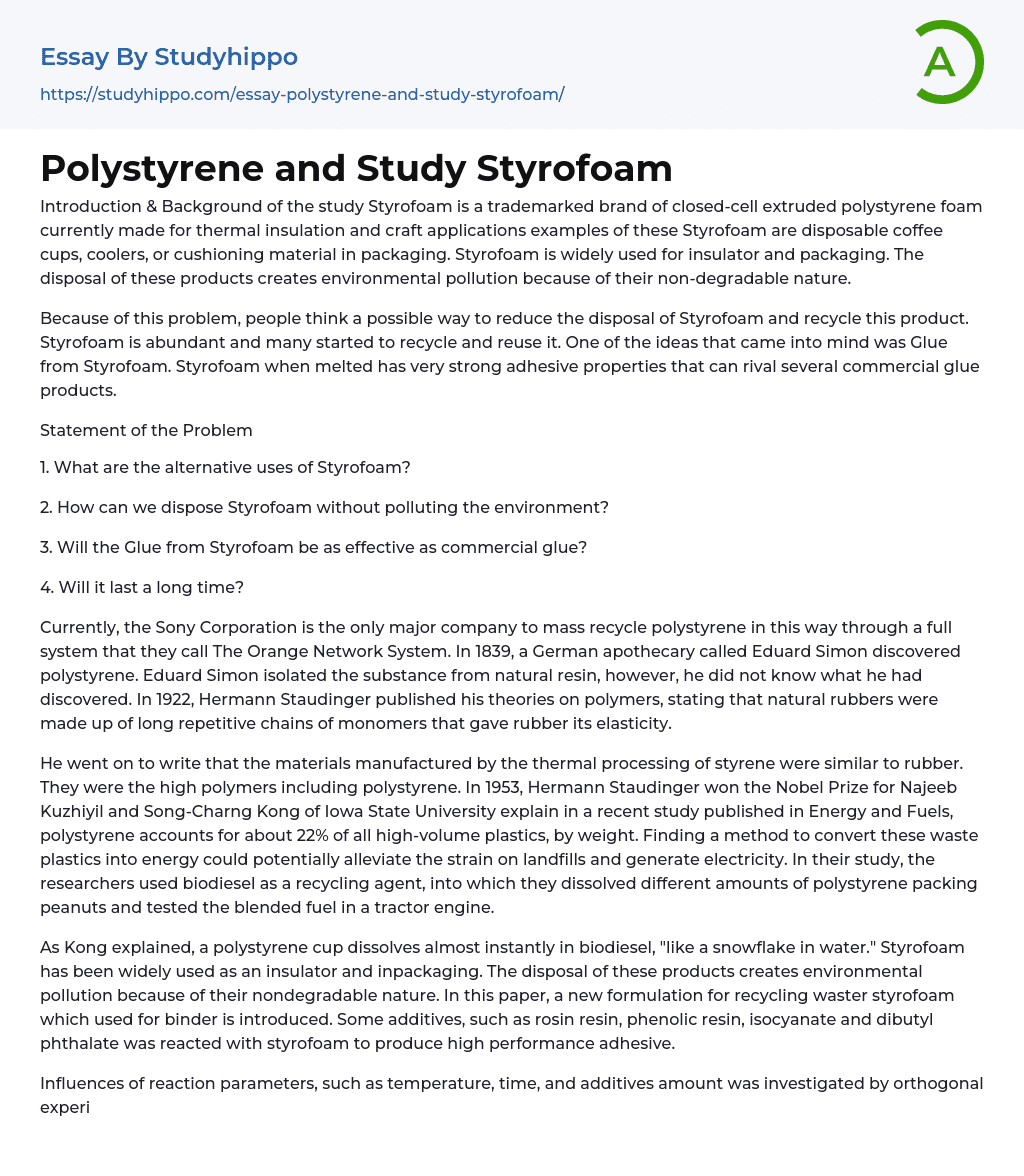Introduction & Background of the study Styrofoam is a trademarked brand of closed-cell extruded polystyrene foam currently made for thermal insulation and craft applications examples of these Styrofoam are disposable coffee cups, coolers, or cushioning material in packaging. Styrofoam is widely used for insulator and packaging. The disposal of these products creates environmental pollution because of their non-degradable nature.
Because of this problem, people think a possible way to reduce the disposal of Styrofoam and recycle this product. Styrofoam is abundant and many started to recycle and reuse it. One of the ideas that came into mind was Glue from Styrofoam. Styrofoam when melted has very strong adhesive properties that can rival several commercial glue products.
Statement of the Problem
1. What are the alternative uses of Styrofoam?
"text-align: justify;">2. How can we dispose Styrofoam without polluting the environment?
3. Will the Glue from Styrofoam be as effective as commercial glue?
4. Will it last a long time?
Currently, the Sony Corporation is the only major company to mass recycle polystyrene in this way through a full system that they call The Orange Network System. In 1839, a German apothecary called Eduard Simon discovered polystyrene. Eduard Simon isolated the substance from natural resin, however, he did not know what he had discovered. In 1922, Hermann Staudinger published his theories on polymers, stating that natural rubbers were made up of long repetitive chains of monomers that gave rubber its elasticity.
He went on to write that the materials manufactured by the thermal processing of styrene were similar to rubber. They were the high polymers including polystyrene. In
1953, Hermann Staudinger won the Nobel Prize for Najeeb Kuzhiyil and Song-Charng Kong of Iowa State University explain in a recent study published in Energy and Fuels, polystyrene accounts for about 22% of all high-volume plastics, by weight. Finding a method to convert these waste plastics into energy could potentially alleviate the strain on landfills and generate electricity. In their study, the researchers used biodiesel as a recycling agent, into which they dissolved different amounts of polystyrene packing peanuts and tested the blended fuel in a tractor engine.
As Kong explained, a polystyrene cup dissolves almost instantly in biodiesel, "like a snowflake in water." Styrofoam has been widely used as an insulator and inpackaging. The disposal of these products creates environmental pollution because of their nondegradable nature. In this paper, a new formulation for recycling waster styrofoam which used for binder is introduced. Some additives, such as rosin resin, phenolic resin, isocyanate and dibutyl phthalate was reacted with styrofoam to produce high performance adhesive.
Influences of reaction parameters, such as temperature, time, and additives amount was investigated by orthogonal experiment. Experimental results showed that the amount of rosin and phenolic resin is the biggest influence factor on the reaction. The optimized formulation was rosin (8-10) %, phenolic resin (8-10) %, isocyanate 10%, BPO 2%, DBP 10%. Under the optimum conditions, peel strength of obtained binder reaches 1.056 kN/m, which is higher than that of commerical milky glue.
Methodology
I. The subject of the study
II. Procedure
In order to make Styrofoam glue at home you will need some items to get the job done properly. So, first gather the
following: Two or Three Styrofoam food containers Limonene/Orange Oil can be purchased at Citrus Depot Large Metal Pot Clean Jar or Jars with lids Once you have your items together, the first thing you'll want to do is get set up in a well ventilated area or go outside. The Limonene has a powerful orange scent and the Styrofoam can be odorous while breaking down. Tear up or cut your Styrofoam into small pieces
Place your polystyrene into the metal pot Start off with pouring 4oz of Limonene onto the Styrofoam. The Styrofoam will then break down into a thin liquid form. Take the resulting liquid, which will amount to about 9oz and pour into a jar. Label it well as "Glue" before you put it away, so you and your household will know what it is later. Chose to use your glue wisely, as it can also act as a type of sealant. Once you use it, just like some of the better super glues it is there to stay and is very hard to get off.
- Organic Chemistry essays
- Acid essays
- Calcium essays
- Chemical Bond essays
- Chemical Reaction essays
- Chromatography essays
- Ethanol essays
- Hydrogen essays
- Periodic Table essays
- Titration essays
- Chemical reactions essays
- Osmosis essays
- Carbohydrate essays
- Carbon essays
- Ph essays
- Diffusion essays
- Copper essays
- Salt essays
- Concentration essays
- Sodium essays
- Distillation essays
- Amylase essays
- Magnesium essays
- Acid Rain essays
- Agriculture essays
- Albert einstein essays
- Animals essays
- Archaeology essays
- Bear essays
- Biology essays
- Birds essays
- Butterfly essays
- Cat essays
- Charles Darwin essays
- Chemistry essays
- Dinosaur essays
- Discovery essays
- Dolphin essays
- Elephant essays
- Eli Whitney essays
- Environmental Science essays
- Evolution essays
- Fish essays
- Genetics essays
- Horse essays
- Human Evolution essays
- Isaac Newton essays
- Journal essays
- Linguistics essays
- Lion essays




